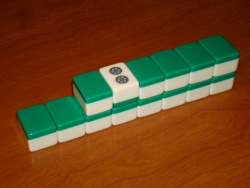Wanpai: Difference between revisions
mNo edit summary |
(→Use) |
||
| Line 11: | Line 11: | ||
The dead wall is always responsible for indicating the dora. Among the dead wall, one tile is flipped and revealed for everyone. This tile is assigned as the '''dorahyouji''' {{kana|ドラ表示}}, or "dora indicator". It is always the third tile on the top row from the initial wall break. Tiles marked as dora are indicated as the next tile in the sequence, as noted in the "[[Dora#Dora order|dora order]]". | The dead wall is always responsible for indicating the dora. Among the dead wall, one tile is flipped and revealed for everyone. This tile is assigned as the '''dorahyouji''' {{kana|ドラ表示}}, or "dora indicator". It is always the third tile on the top row from the initial wall break. Tiles marked as dora are indicated as the next tile in the sequence, as noted in the "[[Dora#Dora order|dora order]]". | ||
== Arrangement == | |||
The fourteen tiles are arranged as follows: | |||
{| class="wikitable" width=50% | |||
|- | |||
|align=center| {{#mjt:9z}} ||align=center| {{#mjt:9z}} ||align=center| {{#mjt:2p}} ||align=center| {{#mjt:9z}} ||align=center| {{#mjt:9z}} ||align=center| {{#mjt:9z}} ||align=center| {{#mjt:9z}} | |||
|- | |||
| 1st kan draw || 3rd kan draw || Dora indicator || 1st kandora || 2nd kandora || 3rd kandora || 4th kandora | |||
|- | |||
|align=center| {{#mjt:9z}} ||align=center| {{#mjt:9z}} ||align=center| {{#mjt:9z}} ||align=center| {{#mjt:9z}} ||align=center| {{#mjt:9z}} ||align=center| {{#mjt:9z}} ||align=center| {{#mjt:9z}} | |||
|- | |||
| 2nd kan draw || 4th kan draw || 1st uradora || 2st uradora || 3rd uradora || 4th uradora || 5th uradora | |||
|} | |||
==External links== | ==External links== | ||
[[Category:Terminology]] | [[Category:Terminology]] | ||
[[Category:Game rules]] | [[Category:Game rules]] | ||
Revision as of 08:41, 12 January 2015

Wanpai 「王牌」 are the tiles used to form the dead wall. These tiles are set aside from the regular draw and discard play. Every mahjong hand session has 14 tiles, or 7 double-stacked tiles, set aside from the regular tile draw and discard processes. These tiles are considered to be out of play, hence the nomenclature "dead wall".
Use
Dead wall tiles are generally inaccessible, unless players call kan. Here, four tiles counterclockwise from the dora indicator are dedicated to kan calls. Even then at all times, the dead wall must be maintained at 14 tiles. In the event of a kan call, a tile is drawn by the player; and so a replacement tile from the end of the regular wall is added to the end of the dead wall.
The dead wall also holds the rinshanpai 「嶺上牌」, which are only accessible via calls for kan. They are the four tiles between the dora indicator and the first cut of the wall. In other words, they are the four tiles immediately clockwise from the dora indicator. For every kan call, a player gains access to the dead wall and draws one rinshanpai. After a discard, one tile from the end of the regular wall gets added to the dead wall, to retain the count of 14-tiles. If the rinshanpai produces a winning tile. then this draw invokes the yaku, rinshan kaihou.
Dora
The dead wall is always responsible for indicating the dora. Among the dead wall, one tile is flipped and revealed for everyone. This tile is assigned as the dorahyouji 「ドラ表示」, or "dora indicator". It is always the third tile on the top row from the initial wall break. Tiles marked as dora are indicated as the next tile in the sequence, as noted in the "dora order".
Arrangement
The fourteen tiles are arranged as follows:
| 1st kan draw | 3rd kan draw | Dora indicator | 1st kandora | 2nd kandora | 3rd kandora | 4th kandora |
| 2nd kan draw | 4th kan draw | 1st uradora | 2st uradora | 3rd uradora | 4th uradora | 5th uradora |